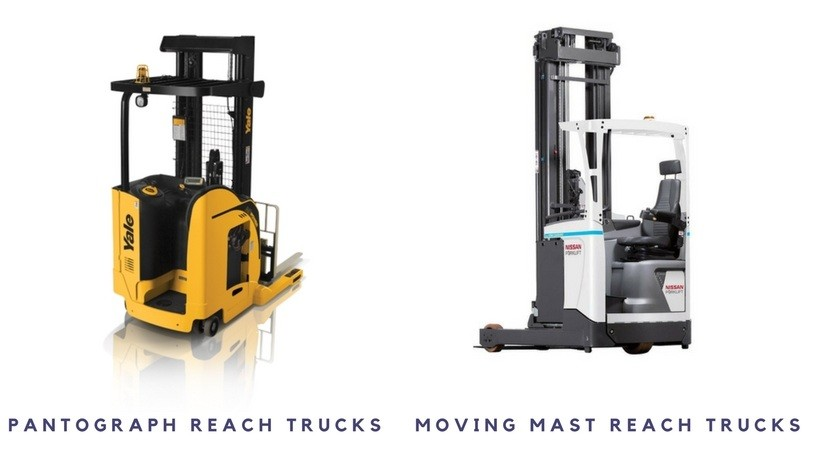
Before you hire or buy a reach truck, you should know the purpose of this equipment and how can they assist you in accomplishing your job. Reach trucks are primarily designed for warehouses having narrow passageways. When operating the machine, the driver sits sideways. Beneath the operator’s seating position, the drive wheel is positioned. Reach trucks have two outer legs that dispense the weight load with a wheel configuration of one or two wheels per leg. Though the reach truck’s wheelbase is of the same length as a standard counter-balance forklift; however, the body is more compact. A reach truck moves the load back within the wheelbase when lifting a load. This allows the reach truck to operate in much narrower aisles as the lesser load is bulging out from the reach truck.
Reach Truck Types
I. Pantograph Reach Trucks
A pantograph reach truck uses the design of a scissor. Its reach mechanism extends the lifting forks forward letting it to reach into racking with a single or a double reach configuration design. Basically, these reach trucks are designed to load pallets by steering into the racking. Hence, racking configurations should be set up to have no limits on the bottom part and bottom pallets should be directly loaded onto the floor. There is also an alternative option for racking configuration. With this alternate option, you should make use of smaller wheels with a higher bottom-bar configuration to let the reach truck travel ahead underneath the racking bottom-bar. When fully extended at double deep reaching, pantographic reach trucks have a higher lifting capacity.
II. Moving Mast Reach Trucks
A moving mast reach truck makes use of a hydraulic system, which is based on rails assisting the whole mast to go ahead. These trucks can efficiently manoeuvre in narrow aisles as well as in dockside because they are fitted with standard larger-diameter wheels, which give them greater ground clearance. The major downside is, without a fork extension attachment, this type of trucks is not able to handle double deep racking.
III. Other Configurations
A reach straddle truck is an unusual form of either type of reach truck. So, it lets the unit to straddle the pallet [i.e. the legs are set aside wider so that legs of the unit can surround the pallet]. This kind of configuration is not suggested because it means that pallets cannot be as closely piled, which will result in a larger mandatory storage area.
Reach Truck Buying Tips
Across industry sectors, reach trucks are essential for warehouses. Here are some very useful tips on what you need to look at when buying or hiring a reach truck.
1. What’s the usage pattern?
You need to ascertain the usage pattern first. For example, if the reach truck will be used nonstop round-the-clock then you need to check whether the truck is strong enough to accomplish the job. Stability is imperative, so ensure that the battery and battery management satisfies the requirements.
2. Height/ range of mast
The majority of reach trucks have a 3-stage mast. Although lift height is imperative, the lowered mast height is also vital. It is essential to ensure that it’s not too tall for internal doorways and passageways as well as the external main door. Verify the ratio of closed height (i.e. h1) to top lift height (i.e. h3).
3. Width of the Aisles
Widths of the Aisles assist in determining the choice of truck.
4. Inspect residual capacities
With every new truck design, residual capacities change, so it’s imperative to inspect the most recent stats from the manufacturer.
5. Structure/ Construction
Ensure that the truck is strong and durable. The build quality of the mast and chassis is vital to guarantee that it can undergo daily stresses and render firmness at height.
6. Lift speed
Seconds add up to valuable minutes over the course of a day, so look for lift speeds in the realm of 0.8 m/s.
7. Moving speed
Moving speed is vital but most of the operations have specific speed limits, which makes the top speed insignificant.
8. Comfort of the driver
Drivers are required to sit in a reach truck for most of their shift timings, so ensure it’s comfortable to reduce exhaustion, which can influence their overall performance.
9. Visual display
The visual display renders critical information to the driver. It comes in various different formats, so test them to see if they are instinctive and simple to read.
10. Steering wheel
Steering wheels differ in size and position from one brand to another. Steering wheels require being very sturdy because many drivers use them to get in and out of the truck. Steering wheels should be easily adjustable otherwise drivers will not use it. However, it is recommended to take feedback from your own drivers.
11. Controls
What is preferred between joystick and mini-levers? Preference of the driver or site history may determine what to prefer. Nonetheless, always try out the options; for instance, test how effortless it is to activate side-shift and tilt.
12. Common mechanism
It’s a good consideration to choose a manufacturer that can demonstrate the reliability and quality of the components. Common controls across warehouse products will assist the drivers greatly to change trucks with ease.
13. Moving or pantograph mast
If double deep racking is used specifically then this is a pragmatic decision to determine whether a moving mast reach truck is suitable or a pantograph [scissor design reach equipment to stretch/lengthen the forks]. Though, it’s prudent to test the performance of each for your fixed operation.